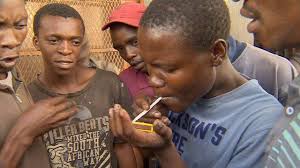Nigeria faces a silent emergency: children as young as 10 are using drugs, with narcotics and cheap local mixtures spreading fast in schools and communities. The 2018 National Drug Survey showed 14.4% of Nigerians (≈14.3m people) used drugs—double the global average—and age of initiation is falling.
Why it’s happening: easy availability of tramadol, codeine, and local cocktails (“monkey tail,” kush), weak parental supervision, peer pressure, and poor treatment access. NDLEA has made big seizures—18,500+ arrests and 2.6m kg drugs seized in 2024—but supply chains adapt.
What must change:


Parents: stronger supervision, open talks from age 9, enforce curfews.
Schools: after-class programs, surveys, fast referrals to treatment.
Faith & community leaders: family support circles, neighborhood curfews.
NDLEA & security agencies: hit supply chains harder, prosecute traffickers, and reinvest seized assets into youth clubs and clinics.
Lessons abroad: Iceland cut teen substance use from 42% to ~5% with parental contracts, after-school activities, and curfews; Portugal reduced harm by pairing tough policing of traffickers with treatment-on-demand.
Bottom line: This is not just a government problem. Parents, schools, faith, and community leaders must step up—while NDLEA and intelligence agencies choke the supply. Without urgent, coordinated action, Nigeria risks losing a generation of achievers to addiction.
Headlinenews.news Special Investigative Report.
Full report, visit: www.headlinenews.news
Nigeria’s Youth Drug Crisis: Blunt Facts, Root Causes, and a Playbook That Works
Dateline: Sept 10, 2025 — Lagos
Underneath Nigeria’s governance debates, a quieter emergency is hollowing out homes, classrooms, and neighborhoods: early-onset drug use and a widening market of cheap, accessible narcotics and concoctions. This report sets out the facts, why the current approach isn’t enough, what has worked elsewhere, and exactly what parents, schools, faith and community leaders, and government can do—starting now.
The Facts
Scale: Nigeria’s first national drug survey found 14.4% of people aged 15–64—about 14.3 million—used drugs in the past year, far above the global average (~5.6%). Cannabis led the pack; misuse of pharmaceutical opioids (tramadol, codeine) was widespread.
Age of initiation is dropping: Evidence from clinical and school studies shows drug use among junior and senior secondary students (10–15 years) and reports of first use from ages 10–29—a red flag for lifelong harm.
Treatment gap: Among high-risk users, many want treatment but a minority receive it—typical estimates <20% treated in a year—so the revolving door continues.
Market reality: West Africa—especially Nigeria—has been a major hub for tramadol and codeine flows, much of it historically originating from India; Africa accounted for >90% of global tramadol seizures in recent years.
Enforcement pressure is up, but supply adapts: NDLEA reports 18,500+ arrests and ~2.6 million kg of drug seizures in 2024, yet significant consignments (e.g., 19.4 kg cocaine at Lagos airport) still break through—proof the market is resilient and adaptive.
Bottom line: We have a large, young at-risk population, early exposure, a porous/innovating supply chain, and a treatment system that can’t keep pace. If we focus only on dramatic raids but don’t choke off entry points or change daily life for kids, we’ll keep losing this fight.
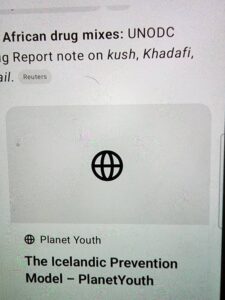
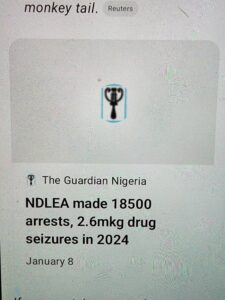
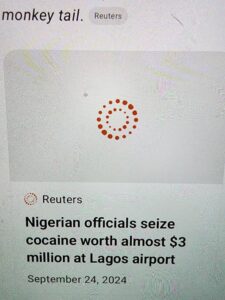
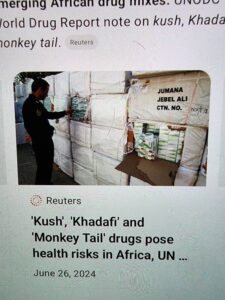
What’s driving 10–17 year-olds into drugs?
Availability & price: Diverted pharmaceuticals and local concoctions (e.g., “monkey tail”—homemade gin + cannabis) are cheap, normalized, and everywhere; new mixes (kush, “Khadafi”) keep emerging.
Weak daily structure: When parental supervision drops—long hours away, status pressure, or absent fathers/mothers—adolescents fill the vacuum with peers and street economies. Nigerian school studies repeatedly tie use to unsupervised time and peer pressure.
Low perceived risk + easy stories to tell themselves: “It’s just cough syrup,” “It helps me read/ hustle,” or “Everyone does it.” The gateway pattern (early alcohol/nicotine/caffeine misuse) is visible.
What has worked elsewhere (and can work here)
1) Iceland’s Prevention Model (IPM): data-driven community discipline
In the late 1990s Iceland had some of Europe’s worst teen substance use. Two decades of parental contracts, curfews, lots of structured after-school activities, annual youth surveys, and binding community compacts cut teen intoxication from 42% to ~5%, daily smoking from 23% to ~3%, and cannabis “ever-use” to ~5–7%. That’s a collapse, not a tweak.
Transferable to Nigeria? Yes—pilot by LGA: yearly anonymous school surveys; LGA-funded activity passes (sports, arts, tech clubs) tied to attendance; parental attendance pledges and SMS check-ins; local curfew bylaws enforced by community and faith leaders (not just police).
2) Portugal’s shift to health + targeted policing
Portugal decriminalized use/possession (not trafficking) in 2001, pairing it with treatment-on-demand, “dissuasion commissions,” and intelligence-led policing. Over time, youth use stayed below EU averages and harms fell where services were funded. (Some critics contest parts of the narrative; the consistent signal is harm drops when treatment and social support are scaled.)
Transferable to Nigeria? We don’t need to copy laws—scale health responses: school-based screening + fast-track referrals, expand community clinics and medication-assisted treatment (MAT) for opioid use where appropriate, and divert non-violent adolescents from courts to family-centered treatment.
A Nigeria-ready playbook (who must do what)
Parents & guardians (primary responsibility)
Non-negotiable routines: homework location, device rules, curfews; know their friends and their spaces.
“Parental contracts” each term: sign with school + faith/community group—attendance at open days, two home-check calls per week, weekend curfew hours, and random bag checks at home.
Substance-use talks start by age 9–10 (age-accurate, zero shaming). Point out how “study drugs” and cough syrups wreck grades, memory, and opportunities. (If you don’t say it, TikTok will.)
Schools & tertiary institutions (secondary responsibility)
Adopt the Icelandic survey rhythm: anonymous annual student surveys (age 10–18) on time use, mental health, and exposure; publish LGA-level dashboards.
Make after-school time safe: 3–6 p.m. club mandate; partner with local sports/arts/tech hubs; require coach/teacher codes of conduct (no normalizing alcohol/vapes).
On-site counselors & quick referrals to NDLEA-linked treatment services; peer-support groups for recovery.
Faith organisations & community leaders (co-owners of prevention)
Neighborhood patrols + curfew support for minors on school nights.
Family circles: monthly, no-shame support groups for parents struggling with supervision or teen behavior.


NDLEA, NAFDAC, Customs, Police, DSS, NIS (government support role)
Go for the foundations of supply—with evidence-gathering tight enough to survive in court.
1. Intelligence fusion & supply-chain attacks
Stand up joint NDLEA–Customs–NAFDAC–DSS tasking focused on tramadol/codeine flows and clandestine meth labs; monitor India–Gulf–West Africa lanes; require pre-arrival data and container risk scoring at ports, however the adoption of the Eden & Frabemar CTN project will practical eliminate the chances of drug importation into Nigeria once Government approves it.
2. Forensic testing & early warnings
Expand lab capacity to detect new street mixes (kush, Khadafi, monkey tail) and issue real-time alerts to LGAs, schools, and clinicians.
3. Visible, consistent enforcement
Keep the pressure (raids/arrests), but prioritise wholesalers and corrupt facilitators; publish quarterly “top 20” network takedowns and asset seizures to change the risk calculus. NDLEA’s 2024 numbers show capability; now make it predictably relentless.
4. Demand-side funding
Earmark 1–2% of seized asset proceeds to finance youth clubs, school counselors, and MAT slots—link seizures to visible community benefit.
Health services (bridge the treatment gap)
Treatment-on-demand pilots in each geopolitical zone: mobile outreach, same-week intake, MAT where clinically indicated, and family therapy (evidence-based).
Train school nurses/NYSC counselors to screen and refer; publish wait-time targets (days, not months). The current unmet need is large.
Addressing common misconceptions—quick reality checks
“This is all foreign drugs corrupting our kids.” Not entirely. Domestic cannabis and local mixes are prevalent alongside imported pharmaceuticals. Both supply streams must be tackled.
“Enforcement alone will fix it.” No. Arrests and seizures matter, but without prevention structure at home/school and real treatment capacity, early teen use keeps rising and markets adapt.
“Our culture is different; Iceland/Portugal won’t translate.” Their mechanics (parental time, structured after-school hours, credible referral systems, and data-driven local action) do translate—if we localize them at LGA scale and back them with leadership.
Immediate 90-day actions (no committees, just do)

1. Three-LGA pilots of the Icelandic model (one per zone in the South & North): baseline youth survey, parental contracts, 3–6 p.m. activity guarantee, and curfew bylaw. Publish results in 6 months.
2. NDLEA–NAFDAC–Customs “Op Tramadol/Codeine Shield” at Apapa/Tin Can/Seme and Abuja/Lagos airports with pre-arrival targeting, inspector rotation, and real-time lab screens. Eden&Frabemar project ensures the narcotics don’t even get into the Nigerian shores.
3. School-clinic fast track: designate one treatment partner per LGA with 48-hour intake for any school referral; Ministry of Education + NDLEA curriculum update already signalled—execute.
4. Faith–community family circles: weekly support groups (script + facilitator pack), hosted by mosques/churches/CSOs; measure attendance, referrals, and school absenteeism changes.
If you’re a parent reading this—start tonight
Collect the phones at 9 p.m.
Meet one other parent in your child’s class and swap supervision notes.
Ask three questions: Who are your closest friends? Where do you hang out 3–6 p.m.? Has anyone offered you pills/syrup/weed?
Small, consistent actions beat one big lecture.
Sources (selected)
National prevalence & treatment gap: Nigeria Drug Use Survey (NBS/UNODC, 2018/2019).
Adolescent (10–15) evidence: Nigerian school-based studies.
Tramadol/codeine flows & seizures: UNODC/INCB/ISS reports; Africa seizure dominance; India-to-West Africa routes.
NDLEA 2024 performance: Arrests/seizures; recent major interdictions.
Iceland Prevention Model results & method: Peer-reviewed and implementation sources.
Emerging African drug mixes: UNODC World Drug Report note on kush, Khadafi, monkey tail.
The National Patriots Research.
Headlinenews.news Special Investigative Report.


